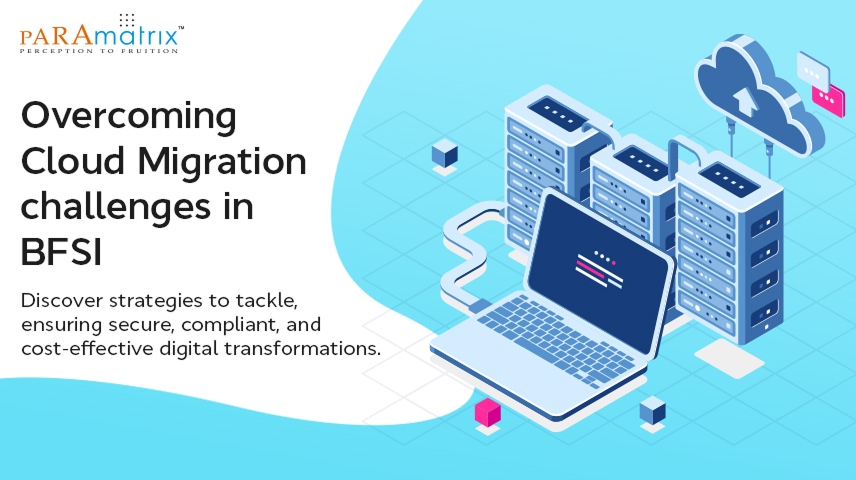Overcoming Cloud Migration challenges in BFSI
November 13, 2024

The dawn of a new era in financial services has arrived, and it's powered by the cloud. As institutions race to modernize their infrastructure, a sobering reality emerges: cloud migration is not without its challenges. Recent industry data paints a complex picture:
- According to a 2021 Flexera report, 92% of enterprises have a multi-cloud strategy, highlighting the widespread adoption of cloud technologies.
- However, a 2020 Unisys study found that 37% of companies have moved applications back from the cloud to on-premises environments, indicating that cloud migrations don't always go as planned.
- The 2021 Thales Data Threat Report revealed that 40% of organizations experienced a cloud-based data breach in the past 12 months..
These statistics underscore a critical truth: while cloud adoption offers significant benefits, the path to successful migration is fraught with potential pitfalls. However, with proper planning and expertise, these challenges can be navigated successfully.
Common Cloud Migration Challenges in Financial Services
1. Data Security and Privacy Concerns
In an industry where data breaches can cost an average of $5.72 million (IBM Cost of a Data Breach Report 2021), robust security is non-negotiable. Many institutions underestimate the complexity of securing cloud environments, leading to vulnerabilities.
2. Regulatory Compliance Complexities
Financial services face stringent regulatory requirements. A 2021 Thomson Reuters survey found that 67% of firms expect the focus on managing regulatory risk to increase. Ensuring cloud infrastructure meets these evolving standards can be daunting.
3. Legacy System Integration Issues
With many financial institutions still relying on legacy systems, seamless integration with cloud platforms often proves more complex than anticipated. A 2020 Accenture report noted that 43% of banks still use COBOL, highlighting the prevalence of legacy technology.
4. Skill Gap and Cultural Resistance
Cloud migration requires new skill sets that many organizations lack internally. A 2021 Gartner survey found that 64% of IT executives cite talent shortages as the most significant barrier to emerging technology adoption.
5. Data Migration and Management Challenges
Moving vast amounts of sensitive financial data to the cloud while ensuring data integrity and accessibility is a significant challenge. A 2020 Precisely study found that 65% of organizations face data quality challenges when migrating to the cloud.
Strategies for Successful Cloud Migration
1. Comprehensive Security Architecture
Implement a robust security framework that addresses data encryption, access controls, and continuous monitoring. The Cloud Security Alliance recommends a shared responsibility model for cloud security.
2. Regulatory Compliance by Design
Incorporate compliance requirements into the migration strategy from the outset. The Financial Stability Board's 2020 report emphasizes the importance of cloud-specific risk assessments and due diligence.
3. Phased Migration Approach
Adopt a gradual migration strategy, starting with non-critical workloads. A 2021 McKinsey study found that organizations using a phased approach were 2.5 times more likely to report a successful cloud migration.
4. Invest in Training and Change Management
Address the skill gap through comprehensive training programs and consider partnering with cloud experts. Deloitte's 2021 Cloud Migration Survey found that organizations investing in cloud skills training were 3 times more likely to meet or exceed their migration goals.
5. Robust Data Governance Framework
Establish clear data governance policies and leverage advanced data management tools. The Cloud Data Management Capabilities (CDMC) framework provides guidelines for financial institutions managing data in the cloud.
The Road Ahead
As financial institutions continue their digital transformation journeys, well-executed cloud migrations are crucial. The potential benefits are substantial:
- Up to 20-30% reduction in IT operational costs (Accenture Banking Cloud Altimeter, 2021)
- 40% improvement in time-to-market for new products (McKinsey Digital Banking Report, 2021)
- Enhanced scalability and flexibility to meet changing market demands.
However, realizing these benefits requires navigating the complex landscape of cloud migration with expertise and precision.
For financial institutions seeking to embark on or optimize their cloud migration journey, expert guidance is invaluable. Paramatrix offers comprehensive cloud migration services tailored to the unique needs of the financial sector. With a deep understanding of both cloud technologies and financial industry requirements, Paramatrix helps institutions avoid common pitfalls and achieve successful, secure, and compliant cloud transformations.
To learn how Paramatrix can guide your institution through a seamless cloud migration journey, click and discover the path to a secure, efficient, and future-ready cloud infrastructure.